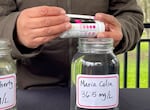
Oregon Rural Action's Ana Maria Rodriguez conducts a rapid test on a jar of water brought from Boardman, Ore.., which tested above the federal standard of 10 milligrams per liter.
Monica Samayoa / OPB
The state claimed early success in its effort to test all domestic wells in the Lower Umatilla Basin for nitrates. But one Eastern Oregon nonprofit says the accomplishment is not the clearcut victory it should be.
The Oregon Health Authority announced Monday that it met its self-imposed goal of contacting every household in the region that draws their drinking water from a well — and offering nitrate testing and other resources — by the end of September.
According to a press release, OHA says those contacts resulted in the collection of more than 1,000 well water samples in the Lower Umatilla Basin Groundwater Management Area, an area that spans much of northern Morrow County and western Umatilla County. About 20% of the samples exceeded the federal standards for nitrates, a chemical that can cause cancer and other illnesses. State officials expect that number to go up as more water samples are collected and tested.
The U.S. Environmental Protection Agency’s standard for safe drinking water is up to 10 milligrams of nitrate per liter.
“I would say that we are feeling strong that we have built the system that we need to offer the opportunity for clean drinking water to everybody with a domestic well,” Gabriela Goldfarb, a public health manager for the governor’s office, said.
Nitrate pollution has been an issue in Eastern Oregon for decades. Fertilizer and wastewater used and produced by irrigated agriculture, dairies, feedlots, industrial operations and other sources include nitrates that seep through the ground and into the groundwater supply. Nitrate consumption has been linked to cancer, thyroid dysfunction and respiratory infections, and is especially hazardous for babies.
Figuring out exactly how many wells in the region the state has tested is still unclear. Goldfarb said some of the 1,000 tests could be separate samples from the same well. And although OHA has identified more than 3,200 households with domestic wells, multiple households sometimes draw from the same well.
With potentially hundreds of wells left untested, Oregon Rural Action says the state didn’t go far enough in its testing efforts.
“Community members continue, as they have for well over a year now, to express their frustration at the lack of urgency exhibited by state agency personnel,” the nonprofit wrote in a press release. “Not only has testing by the Oregon Health Authority been unacceptably slow, but the Department of Environmental Quality and Department of Agriculture have failed to take meaningful steps to rein in the industrial-scale practices that contaminated local groundwater in the first place, nor have they held polluters accountable for the harm they have caused.”
The La Grande nonprofit has been heavily involved in the nitrate response over the past year. Oregon Rural Action helped organize a community forum about nitrates in Boardman when Gov. Tina Kotek visited Morrow County in May. Before the meeting was over, Kotek pledged that her administration would take more action to help solve the problem.
Kotek helped secure money from the Legislature to help fund well testing, filters and clean water deliveries through June 2025. In an interview, Oregon Rural Action organizer Kaleb Lay acknowledged that collecting 1,000 well water samples represented significant progress.
Even so, Lay said OHA could have made more face-to-face contact with well owners, especially given the urgency of the situation.
“It’s a matter of public health,” he said. “For some folks, it’s a matter of life and death.”
Goldfarb said she found Oregon Rural Action’s criticisms confusing. Agency leaders considered the organization one of its community partners, she said, and they often incorporated the nonprofit’s suggestions into state public information and testing campaigns.
Goldfarb said there were gaps in testing for a variety of reasons. About 1,200 households displayed “no trespassing” signs, or they had a “hostile dog,” so OHA mailed testing information instead. Other canvassers couldn’t reach people who weren’t home, while about 500 households outright refused testing.
Goldfarb said OHA could resume door-to-door canvassing next spring, but will continue to send mail to residents with untested wells, in addition to continuing a media advertising campaign that includes billboards and radio advertisements. .
Even with OHA’s outreach efforts, Goldfarb admitted there’s still a lot of work to do both in the short-term and the long-term. Besides continuing to try to reach well owners for initial testing and retesting, Goldfarb said discussions continue about connecting domestic well owners to municipal water systems, but that process could take up to 10 years.
And addressing the source of nitrate pollution is expected to take even longer. The state departments of agriculture and environmental quality are responsible for regulating nitrate contamination. If they take a tougher stance on polluters, it could take decades before groundwater quality improves.
Editor’s note: A previous version of this story used the wrong figure for the number of households with domestic wells. There are more than 3,200 households with domestic wells in the Lower Umatilla Basin.